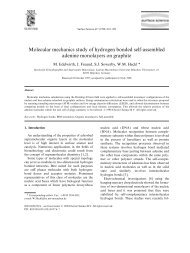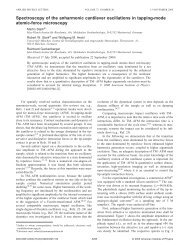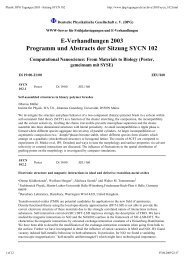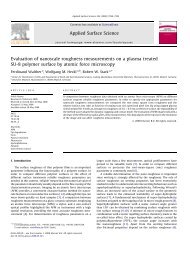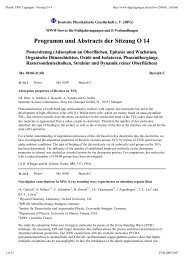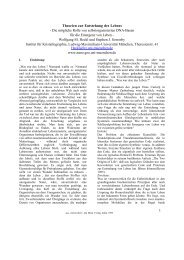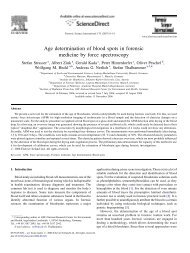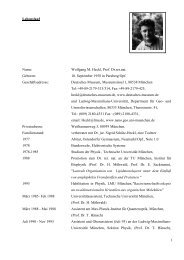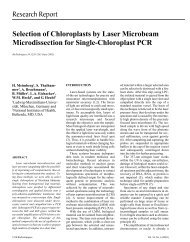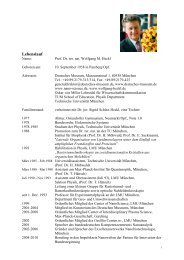Physik: DPG Tagungen - Sitzung O 28 - Nano-science.de
Physik: DPG Tagungen - Sitzung O 28 - Nano-science.de
Physik: DPG Tagungen - Sitzung O 28 - Nano-science.de
Create successful ePaper yourself
Turn your PDF publications into a flip-book with our unique Google optimized e-Paper software.
<strong>Physik</strong>: <strong>DPG</strong> <strong>Tagungen</strong> - <strong>Sitzung</strong> O <strong>28</strong><br />
http://www.dpg-tagungen.<strong>de</strong>/archive/2004/o_<strong>28</strong>.html<br />
The scattering of light by small particles has been intensively researched in the last <strong>de</strong>ca<strong>de</strong>s. The well known<br />
<strong>de</strong>pen<strong>de</strong>ncies of the scattering of light on the size, shape, material and environment of the particles reveals the<br />
complexity of the problem. Several publications have shown numerical simulations and experimental results<br />
<strong>de</strong>monstrating resonances and local field-enhancements on sub-wavelength particles.<br />
Particles of size comparable to the wavelength and of sub-wavelength size, of planar geometry i.e. where the<br />
thickness is much smaller than their linear dimensions, are of great interest in photonics.<br />
We have investigated planar particles of different shapes by confocal and SNOM microscopy. These particles<br />
show interesting <strong>de</strong>pen<strong>de</strong>ncies on the direction of the inci<strong>de</strong>nce of light, on polarization and on the dielectric<br />
constant of the material.<br />
We have observed important differences in the scattering patterns for each material, and each relative orientation<br />
of the particles with the direction of inci<strong>de</strong>nce of the light.<br />
O <strong>28</strong>.47 Poster Mi 16:00 Bereich C<br />
Self-imaging observed on colloid crystals and Fischer projection patterns<br />
•Manuel Gonçalves und Othmar Marti<br />
Department of Experimental Physics, University of Ulm, D-89069 Ulm, Germany<br />
The self-imaging phenomenon in optical systems is known since the Talbot effect was discovered in the 19th<br />
century. The Talbot effect is generated by the interference of the incoming light from a diffraction array of<br />
apertures of size a that takes place near the array (Fresnel zone). In general, a >> λ.<br />
Apertures separated by a distance d, when illuminated by a coherent and plane wave of wavelength λ produce<br />
self-images at distances d T = ν 2 d 2 / λ, for ν = 1, 2, ... [1],[2].<br />
We have observed that arrays of colloidal crystals of polystyrene spheres with diameter of few µm produce<br />
self-images, at distances of several tenths of µm. The theoretical Talbot length is compared with the measured<br />
distances for self-images, for different illumination mo<strong>de</strong>s of coherent light.<br />
A discussion of the multiple scattering and diffraction of light by a regular array of colloidal particles is<br />
introduced and analyzed.<br />
[1] K. Patorski, in Prog. Opt. XXVII, Elsevier, 1989.<br />
[2] A. Lohmann and J. A. Thomas, Appl. Opt., 29 29, 4337-4340.<br />
O <strong>28</strong>.48 Poster Mi 16:00 Bereich C<br />
Plasma CVD-grown carbon nanotubes studied by field emission<br />
•Daniell Malsch 1 , Martin Sveningsson 2 , Eleanor Campbell 2 und Juergen A. Schaefer 1<br />
1 Institut für <strong>Physik</strong> und Zentrum für Mikro- und <strong>Nano</strong>technologien, TU Ilmenau, P.O. Box 100565, 98684<br />
Ilmenau, Germany<br />
2 Department of Experimental Physics, Gothenburg University and Chalmers University of Technology, 41296<br />
Gothenburg, Swe<strong>de</strong>n<br />
Films of carbon nanotubes show an excellent field emission behaviour that allows a wi<strong>de</strong> range of application in<br />
field emitting <strong>de</strong>vices. The influence of the different emission parameters has to be investigated in or<strong>de</strong>r to<br />
improve their performance. We study the field emission of vertically aligned PCVD-grown multiwall carbon<br />
nanotubes. A systematic influence of the tube length on the emission current, the light emission, and the surface<br />
temperature of the film is found. We also examine blackbody radiation from resistive heating during field<br />
emission. This leads, in agreement with light emission behaviour and long-time stability measurements, to a<br />
stepwise <strong>de</strong>gradation of the carbon nanotube films.<br />
17 of 32 07.06.2009 22:14



